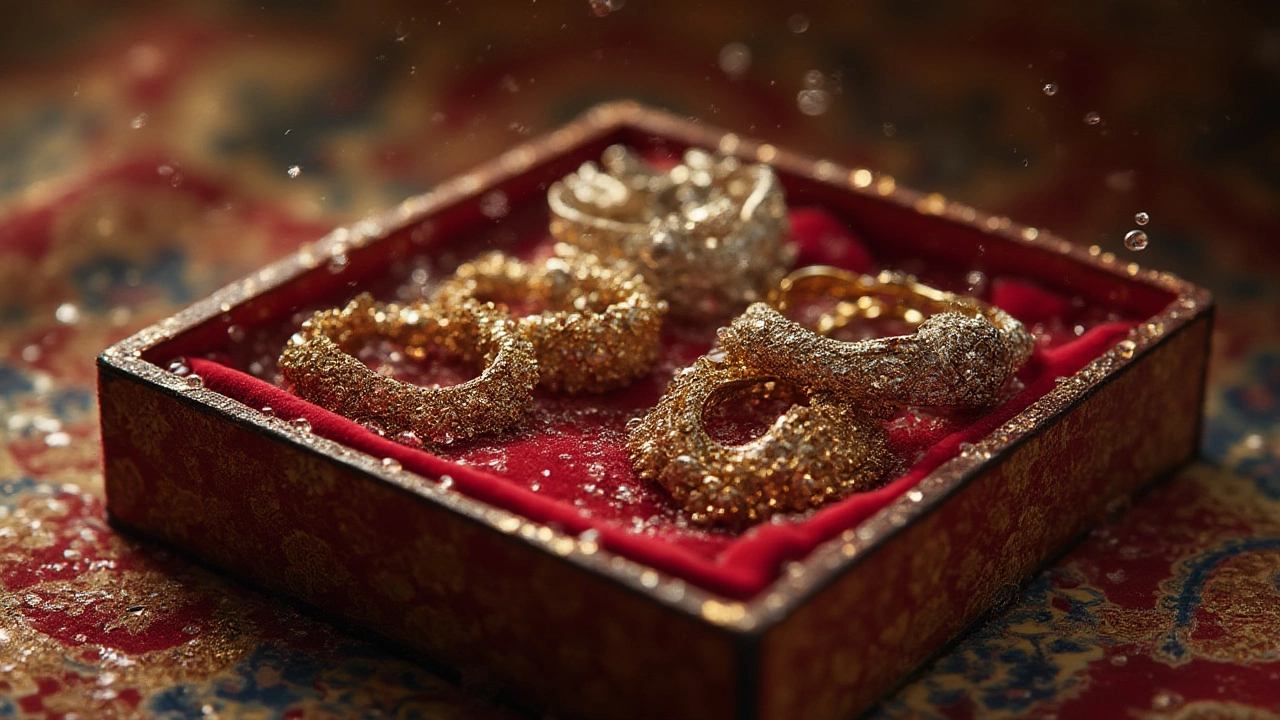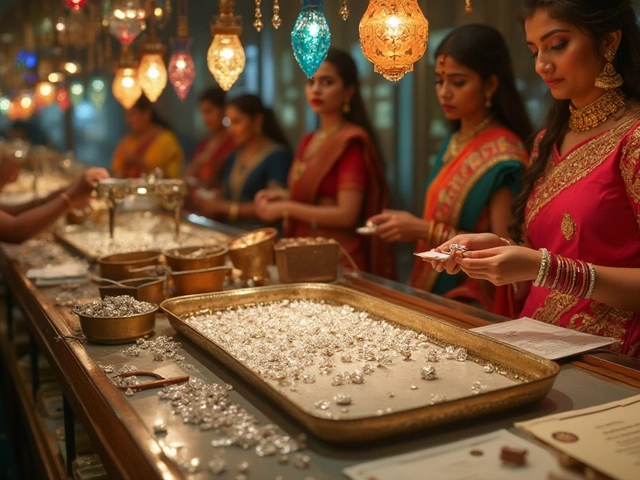
You probably remember that sinking feeling—taking off a favorite ring only to find it tarnished, or noticing your favorite necklace dull after a dip in the pool. Water can mess with jewelry more than you’d think. Most pieces aren’t made to survive wet adventures, whether it’s rain, sweat from a hard gym session, or your daily shower. The truth is, you don’t have to settle for jewelry aging way before its time. There are clever ways to waterproof what you wear, so you can keep your rings sparkling and necklaces fresh—without a secret handshake or expensive gadget involved.
What Damages Jewelry: Why Water Is the Enemy
Most jewelry pieces look tougher than they are. Modern metals like stainless steel might hold up better than vintage silver, but almost everything from gold to costume jewelry feels the sting of water. Here’s the thing—water isn’t just water. There’s chlorine in swimming pools, salt in the ocean, and chemicals in tap. All of these can speed up tarnish, rust, or cause stones to loosen. Even humidity can get the wheels turning on corrosion over time. You might have guessed this, but gold isn’t really invincible either. While pure gold resists tarnishing, most jewelry mixes gold with cheaper metals to boost strength. When those metals meet moisture, tarnish sneaks in.
Ever left a ring on after an intense workout? Sweat is salty, and all that sodium is like an open invitation for corrosion. Sparky (my dog) once knocked a bracelet into a puddle outside, and Luna, the cat, batted one into the bathtub—both pieces lost their shine quickly. Gemstones, especially porous ones like turquoise or opal, are even more sensitive. Water can sneak into tiny cracks, making stones look cloudy or even causing them to crack under stress. Keeping jewelry dry isn’t just about looks, either. In a UK study, nearly 60% of regular ring-wearers noticed some form of water-related damage over a single rainy season. Most didn’t realize it until a clasp broke or a stone dulled.
Let’s talk about everyday things—washing hands, doing laundry, or getting caught in the rain. I set down my watch on a kitchen counter for five minutes, and a small spill I didn’t notice left the back foggy. Even if your pieces survive repeated splashes, microscopic gaps can slowly collect minerals and dirt. These build up over time and weaken prongs or glue. When we look at jewelry under a microscope, you’ll actually see greenish or brownish corrosion setting up shop—this gets way worse with moisture. So, if keeping jewelry bone-dry is nearly impossible, the answer is learning how to properly waterproof it.
DIY Waterproofing: Kitchen and Craft Solutions That Work
Here’s where it gets practical. If you’re fast on your feet, you can do a lot with stuff you probably have kicking around at home. Nail polish is the classic go-to. Clear polish creates a thin, mostly invisible barrier that hugs the metal or stone. Apply two thin layers, wait an hour or so for them to dry, and it’ll drastically slow down tarnish. This was my grandma’s trick for costume rings—Felix still laughs remembering her explaining it like sharing state secrets. The only catch: after a month or two, it’ll wear off, so you’ll need to reapply.
Another top method is using clear spray acrylic sealant. You’ll spot it at hardware stores, art supply shops, or even in some big-box stores. This stuff is seriously tough. Put jewelry on a sheet of newspaper, spray from about eight inches away, and turn it after a few minutes to coat all sides. Let it dry fully (at least a couple of hours), or the piece could get tacky. Don’t use spray sealant for rings with intricate inlays or delicate stones, since it leaves residue in tiny crevices. And no—don’t try super glue. It’s tempting, but it never dries perfectly clear and gets gummy with time. Also, skip household oils. They might look shiny but don’t last and can stain clothes.
If you love resin, you can use a two-part epoxy resin to coat pendants and beads. This creates a glassy, rock-hard surface. You’ll need gloves and a steady hand so it doesn’t pool or drip. Some jewelry artists swear by UV resin too—it cures fast under a small UV lamp, preventing drips. Just know that resins aren’t reversible—once it’s on, it’s permanent. I sealed a handful of Felix’s homemade friendship necklaces with resin. Two years later, they still look nearly new, even after they’ve gone through the wash by mistake.
For wooden jewelry, beeswax is your best friend. Rub a little over each piece, then buff with a soft cloth. Wood sucks up moisture quickly otherwise, making it crack or warp. Beeswax smells nice, too—it’s basically the only household waterproofing that won’t irritate sensitive skin, which is handy if Sparky decides to chew on a bangle again. If you have silver jewelry, stick with specialty silver protective sprays rather than homemade concoctions. Those are tested for safety and won’t alter the color. But when you’re in a pinch, a high-quality carnuba wax polish from the auto aisle actually works wonders, especially for watches and plain metal pieces.

Professional Options: Stuff Jewelers Trust
If you want something longer-lasting or less fiddly than home hacks, check out what pros recommend. Professional jewelers use micro-thin layers of rhodium plating not just for shine, but for shield-like protection. Yes, you can actually ask a jeweler to re-plate gold or silver, and rhodium is way less reactive to water. Expect to pay more—think $50 to $150 for small items—but the finish can last up to three years even if you’re rough on your pieces.
There’s also PVD (Physical Vapor Deposition) coatings, which sound sci-fi but just means a very tough, almost molecular layer goes on with fancy tech. It’s common for watches and high-end bracelets. Labs have shown that PVD coatings can boost corrosion resistance by up to 100 times, especially for steel and titanium jewelry. You’ll usually need to send pieces away or ask your local jeweler if they offer it. But if you’ve got that one ring you can’t live without, the cost pays off. Jewelers sometimes use “Nano Coating” sprays, too. These are made for industrial metal parts but work great on jewelry. They’re invisible, odorless, and don’t rub off easily. Some shops even have a “water test” where you dip your piece after treatment, and you’ll see water bead right up like it’s magic. While not every jewelry shop has them, it’s worth asking, especially if you live near a city.
Want some hard data? Take a look at this breakdown showing how different professional treatments handle water exposure (measured in weeks before noticeable changes):
| Treatment Type | Protection Duration (weeks) | Visible Changes |
|---|---|---|
| Clear DIY Nail Polish | 4-6 | Minor dulling |
| Spray Acrylic Sealant | 10-14 | Possible yellowing |
| Epoxy/Resin Coating | 24+ | Permanent shine, possible cracks if hit |
| Rhodium Plating | 80-150 | Fading after years |
| PVD Coating | 100-200 | Rare visible damage |
| Nano Spray Coating | 60-90 | Virtually invisible, needs refreshment |
If you’ve ever bought “waterproof jewelry” online, it’s usually plating or nano coatings in action. Always ask for details though, because cheap imitations can be hit or miss, and there are no free lunches when it comes to permanent solutions. Cheap coatings flake fast—and then you’re worse off than before because cleanup is a nightmare.
Common Waterproofing Mistakes and Myths
Internet advice for waterproofing jewelry is everywhere, but most of it is wishful thinking (or clickbait). First, avoid hair spray. Some blogs swear it adds shine, but it’s loaded with alcohol and dries out both metals and stones, speeding up corrosion. Also, don’t dunk precious jewelry in “miracle” cleaners or soda—acids etch metals and wreck soft stones. We tried it with an old pair of Sparky’s dog tags; all I got was a weird pink residue and a confused dog.
Another classic mistake: “waterproof” doesn’t mean “lifeproof.” Most coatings can take rain, a hand-wash, or even a swim, but they break down under hardcore use. Chlorine from pools is particularly nasty, even for coated pieces. It eats at the protective layer twice as fast as plain water. So if you swim for exercise, take jewelry off beforehand—or at least rinse it right after and blot dry.
Don’t coat watches with acrylic or resin if you ever want to get inside them for a battery change. Same for anything with moving parts. And while clear polish seems like a miracle, it will flake on flexible items like woven chains or thin bangles. Shiny as they look on day one, anything soft or bendy needs a spray, not a brush-on solution.
The big myth: gold is waterproof. Unless you’re rocking 24k solid gold (which few of us are), the mix of copper or silver alloys underneath means water attacks with every wear. Every once in a while, someone on a jewelry forum will say toothpaste is a secret shining weapon. Don’t. Most toothpaste contains abrasives—try it, and your polished ring will be scratched up faster than Luna running from Sparky.
If you pick up secondhand or vintage jewelry, always clean thoroughly before waterproofing. Otherwise, you’ll just trap old grime and sweat beneath your new seal. My neighbor thought dipping her inherited necklace in silicone spray was genius, until she couldn’t get rid of the original musty smell because it was now sealed inside.

Everyday Habits: Keeping Jewelry Safe Without the Fuss
Even with all the coatings and sprays in the world, nothing beats a smart routine. One underrated hack? Rotate what you wear. Felix and I set up a small tray by the door, so we don’t forget to drop rings and bracelets before heading to Sparky’s favorite muddy park. Keeping jewelry out of the bathroom (especially steamy showers) is such a game-changer for gold and silver. I bought a little jewelry dish for the kitchen, too—no more rings slipping down the drain doing dishes.
Storage makes a big difference. Humidity can sneak into any container, so if you live somewhere damp, grab a handful of silica gel packs (the ones hiding in new shoes) and toss them in your jewelry box. They suck up moisture better than rice. Another tip: wipe down your jewelry quickly with a soft, dry cloth before bed. Oils from your skin and sweat are the main culprits of tarnish—sometimes more than water itself.
If you get caught in a storm or forget a piece before a swim, don’t panic. Rinse right away with fresh water, pat dry, and wait a few hours before slipping it back on. Trapped moisture causes damage over time, so don’t just towel off and call it good. For anyone who loves running or going to the gym with jewelry on, rinse and dry after intense workouts too. I had to replace a favorite fitness tracker band because the sweat and water combination was just brutal to the material and clasp.
Finally, if you’re just starting to build your jewelry collection, look for pieces labeled “marine grade stainless steel” or “titanium.” Both are way more resistant to water damage from the start. Even though DIY and professional coatings are smart for nearly any piece, it’s much easier to start with strong materials that need less babysitting.
When you make waterproofing part of your routine, you get out in the world and don’t stress every puddle, rainstorm, or beach day. Felix always asks why Sparky’s collar tags shine brighter after a simple coat of clear sealant—not magic, just one easy waterproofing habit at a time.


